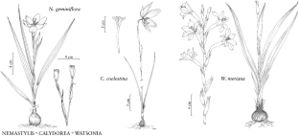Difference between revisions of "Watsonia meriana"
Gard. Dict. ed. 8, Watsonia no. 1. 1768.
FNA>Volume Importer |
imported>Volume Importer |
||
| Line 6: | Line 6: | ||
|place=8, Watsonia no. 1. 1768 | |place=8, Watsonia no. 1. 1768 | ||
|year=1768 | |year=1768 | ||
| + | }} | ||
| + | |special_status={{Treatment/ID/Special_status | ||
| + | |code=I | ||
| + | |label=Introduced | ||
| + | }}{{Treatment/ID/Special_status | ||
| + | |code=F | ||
| + | |label=Illustrated | ||
}} | }} | ||
|basionyms={{Treatment/ID/Basionym | |basionyms={{Treatment/ID/Basionym | ||
| Line 32: | Line 39: | ||
|habitat=Roadsides and grassy banks | |habitat=Roadsides and grassy banks | ||
|distribution=Calif.;South Africa. | |distribution=Calif.;South Africa. | ||
| + | |introduced=true | ||
|discussion=<p>Most <i>Watsonia</i> plants recorded from North America correspond to the triploid, sexually sterile form of <i>W. meriana</i>, also known as W. bulbillifera, which reproduces by means of cormlets produced at the aerial nodes. Most of the flowers do not produce capsules, but a few, containing viable seeds, are occasionally formed. Chromosome number in the Californian plants has not been determined.</p> | |discussion=<p>Most <i>Watsonia</i> plants recorded from North America correspond to the triploid, sexually sterile form of <i>W. meriana</i>, also known as W. bulbillifera, which reproduces by means of cormlets produced at the aerial nodes. Most of the flowers do not produce capsules, but a few, containing viable seeds, are occasionally formed. Chromosome number in the Californian plants has not been determined.</p> | ||
|tables= | |tables= | ||
| Line 54: | Line 62: | ||
|publication title=Gard. Dict. ed. | |publication title=Gard. Dict. ed. | ||
|publication year=1768 | |publication year=1768 | ||
| − | |special status= | + | |special status=Introduced;Illustrated |
| − | |source xml=https:// | + | |source xml=https://bibilujan@bitbucket.org/aafc-mbb/fna-data-curation.git/src/bb6b7e3a7de7d3b7888a1ad48c7fd8f5c722d8d6/coarse_grained_fna_xml/V26/V26_826.xml |
|genus=Watsonia | |genus=Watsonia | ||
|species=Watsonia meriana | |species=Watsonia meriana | ||
Revision as of 22:21, 27 May 2020
Plants sometimes growing in dense clumps, 50–200 cm. Corms tunicate, depressed-globose, 30–45 mm diam.; tunic fibrous, fibers coarse, reticulate. Stems simple or 1–2-branched, often with large cormlets in proximal axils, occasionally also in distal axils of stem, spike. Leaves 4–6, basal leaves 3–4, blade lanceolate, 12–35 mm wide; cauline leaves smaller than basal, blade with margins and midribs hyaline, heavily thickened. Spikes 8–12(–25)-flowered; spathes often flushed with red, outer 18–30 mm, dry in distal 3–5 mm, inner slightly longer to slightly shorter than outer. Tepals orange, red, or purple, lanceolate, outer slightly narrower than inner, 22–27 × 8–15 mm; perianth tube proximally slender, 18–25 mm wide, abruptly expanded distally, 20–25 mm wide; filaments 35–45 mm; anthers 8–12 mm; ovary oblong, 3–4 mm; style branching opposite middle of anthers; branches 6–7 mm. Capsules 22–30 mm. Seeds prominently winged distally, weakly or not winged proximally, 10–18 mm.
Phenology: Flowering May–Jul.
Habitat: Roadsides and grassy banks
Distribution
Introduced; Calif., South Africa.
Discussion
Most Watsonia plants recorded from North America correspond to the triploid, sexually sterile form of W. meriana, also known as W. bulbillifera, which reproduces by means of cormlets produced at the aerial nodes. Most of the flowers do not produce capsules, but a few, containing viable seeds, are occasionally formed. Chromosome number in the Californian plants has not been determined.
Selected References
None.
